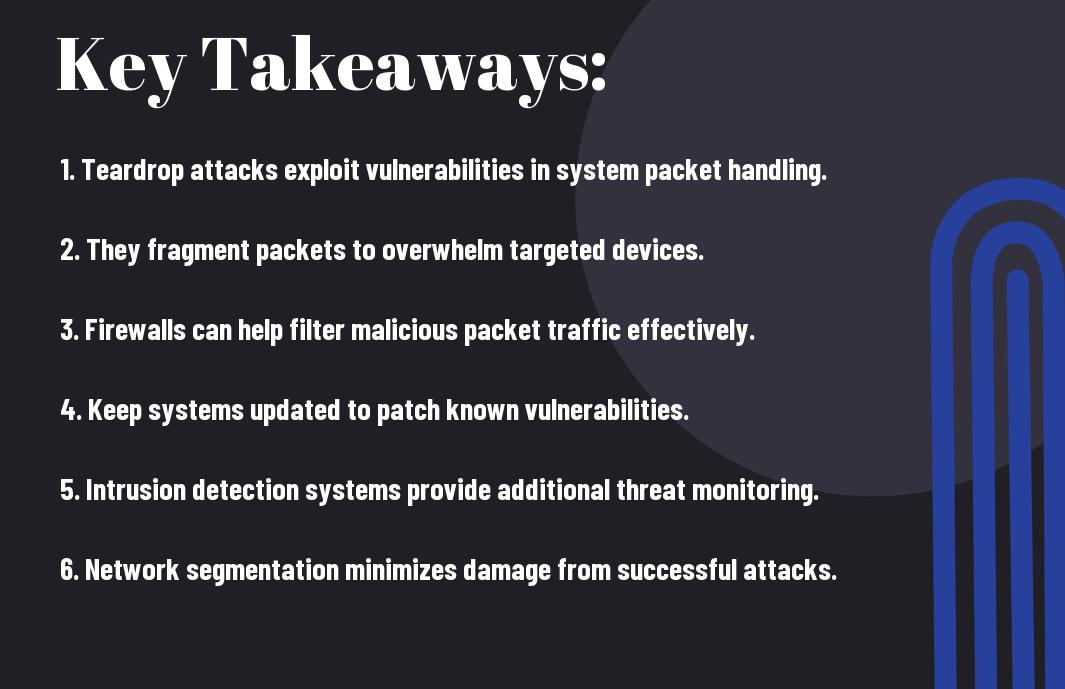Just like any other cyber threat, understanding a Teardrop attack is vital for safeguarding your network. This type of denial-of-service attack exploits vulnerabilities in the TCP/IP protocol to overwhelm your system, causing disruptions. In this post, you will learn what a Teardrop attack entails, how it operates, and most importantly, effective strategies you can employ to protect your systems and data from these malicious threats. Staying informed and proactive is key to ensuring your online security.
Key Takeaways:
- A Teardrop attack is a type of denial-of-service (DoS) attack that targets vulnerabilities in networked systems by sending malformed packets to crash the target device.
- Prevention measures include implementing network firewalls, updating system software regularly to fix vulnerabilities, and using intrusion detection systems to monitor for unusual traffic patterns.
- Ensuring devices and applications are configured to ignore or drop malformed packets can significantly reduce the risk of being affected by a Teardrop attack.
Understanding Teardrop Attacks
For anyone looking to bolster their cybersecurity awareness, understanding teardrop attacks is necessary. This type of cyber assault exploits vulnerabilities in the TCP/IP protocol by sending fragmented packets that aim to crash or freeze target systems. By grasping how these attacks occur, you can better protect your network and devices from potential disruptions.
Definition of Teardrop Attacks
Below, teardrop attacks are defined as a form of denial-of-service attack in which malformed packets are sent to a target machine. These packets are broken into fragments that the machine struggles to reassemble, leading to system crashes or instability. Understanding this definition is a cornerstone of preventing such vulnerabilities in your network.
How Teardrop Attacks Work
Definition of teardrop attacks involves intricate manipulation of how data packets are processed by your system. Essentially, attackers send fragmented packets that, when reassembled, create overlaps and confusion in the original data flow. As a result, this can overwhelm your system resources, leading to severe slowdowns or crashes.
For instance, when the target network receives these fragmented packets, it attempts to reassemble them based on their sequence. However, due to intentional misconfiguration in the fragment data, your system encounters unexpected behavior, often rendering it unable to continue functioning correctly. This vulnerability can lead to service disruptions, emphasizing the importance of employing robust security measures to detect and prevent such attacks on your network.

Historical Context
Assuming you are exploring the world of cybersecurity, understanding the historical context of teardrop attacks can provide valuable insights. These types of attacks have evolved over time, highlighting the persistent nature of cyber threats. By familiarizing yourself with their origins and notable incidents, you can better appreciate the significance of implementing robust security measures in your own digital practices.
Origins of Teardrop Attacks
Across the annals of computer history, teardrop attacks emerged in the late 1990s as a significant vulnerability, exploiting weaknesses in the way operating systems handle fragmented packets. This early form of Denial-of-Service (DoS) attack targeted various systems, prompting a reevaluation of network security strategies.
Notable Incidents
An important aspect of understanding teardrop attacks involves examining notable incidents that have occurred over the years, which raise awareness of their impact on cybersecurity. These incidents have not only affected individual users but have also compelled organizations to tighten their defenses against such vulnerabilities.
Historical instances of teardrop attacks have showcased their potential to disrupt services, urging you to stay informed about potential threats. One notable incident occurred when a large-scale attack targeted multiple organizations, demonstrating the widespread vulnerability in network systems at the time. Such events have emphasized the need for ongoing vigilance and the importance of utilizing strong security protocols to safeguard against similar breaches in your own digital environment.
Identifying Teardrop Attacks
Once again, understanding the signs of a teardrop attack is key to protecting your network. These attacks can often be difficult to pinpoint, as they involve malformed packets designed to exploit vulnerabilities in your operating system. By monitoring your network for unusual patterns or sudden spikes in traffic, you can identify potential teardrop attacks before they escalate into more significant issues.
Symptoms of an Attack
Symptoms of a teardrop attack may include system crashes, slow performance, and unusual error messages. Your devices might exhibit erratic behaviors, such as freezing or failing to respond to input. Observing these symptoms can alert you to the presence of an ongoing attack and prompt you to take preventive measures.
Tools for Detection
Teardrop attacks can be effectively detected using specialized software tools designed for network monitoring and intrusion detection. Proprietary solutions often include features to analyze and track traffic patterns, helping you catch malicious traffic in real-time.
Further, many open-source network analysis tools are also available to assist you in detecting these types of attacks. Utilizing software like Wireshark or Snort allows you to scrutinize packet data for anomalies. By incorporating a combination of these tools, you can enhance your network’s security posture, making it easier to detect and respond to teardrop attacks swiftly.
Prevention Strategies
Now that you understand what teardrop attacks are, it’s crucial to put effective prevention strategies in place. By implementing robust security measures, you can defend your network and minimize the risk of these attacks. Focus on a multifaceted approach that combines technology, best practices, and employee training to create a more secure environment for your systems and data.
Network Security Measures
After assessing your current security posture, invest in advanced network security measures to prevent teardrop attacks. This includes deploying firewalls, intrusion detection systems, and intrusion prevention systems that can filter malicious traffic before it enters your network. Additionally, consider utilizing VPNs and secure configurations for your devices to further fortify your network against potential threats.
Patch Management
The importance of patch management cannot be overstated in the prevention of teardrop attacks. Regularly updating your systems and software with the latest security patches mitigates vulnerabilities that attackers exploit. By ensuring that all components of your infrastructure are up-to-date, you strengthen your defenses and reduce the likelihood of successful attacks.
Security vulnerabilities often arise when software and systems are not kept current. Regular patch management creates an opportunity for you to address known issues before they can be exploited by cybercriminals. Establish a routine schedule for applying patches and updates, and prioritize critical systems that are most likely to be targeted. By treating patch management as an ongoing priority, you enhance your ability to prevent teardrop attacks and maintain the integrity of your network.

Responding to an Attack
All organizations must act swiftly and decisively when a Teardrop attack is detected. Your first response should be to isolate the affected systems to prevent further infiltration and data breaches. Inform your IT team or cybersecurity experts immediately and follow your incident response plan for thorough communication and action.
Immediate Action Steps
Behind the successful mitigation of a Teardrop attack lies a clear and organized response. Start by disconnecting any affected systems from the network and assess the damage. Gather evidence, such as logs and alerts, to help identify the source and nature of the attack, and prevent future occurrences.
Recovery Protocols
An effective recovery process is necessary to restore your systems and data after an attack. Once the immediate threat is contained, you should focus on analyzing the attack’s impact and repairing any damage. This often involves restoring from backups, updating security measures, and conducting a thorough review of your current cybersecurity practices.
For instance, after recovering from a Teardrop attack, conduct a complete system audit to ensure no vulnerabilities remain. Establish a timeline for system restoration and reinforce training for your staff on recognizing potential attacks. This proactive approach not only helps in recovery but also strengthens your overall security posture against future threats.

Future of Teardrop Attacks
Not many experts can predict the future landscape of cyber threats accurately, but teardrop attacks are expected to evolve alongside advancements in technology. As cybercriminals become more sophisticated, they may refine their techniques, making it challenging for traditional security measures to keep pace. Understanding these potential developments empowers you to stay prepared and adjust your cybersecurity strategies accordingly.
Evolving Techniques
After years of using similar methodologies, cybercriminals continue to develop new tactics for conducting teardrop attacks. These evolving techniques may involve exploiting unknown vulnerabilities or leveraging advanced machine learning algorithms to craft more effective payloads. Staying aware of these changes will help you implement stronger defenses to protect your systems from potential threats.
Trends in Cybersecurity
For the future of teardrop attacks, keeping an eye on cybersecurity trends is vital. As organizations prioritize security, tools and practices continually adapt to meet emerging threats. This adaptability allows you to address vulnerabilities before cybercriminals can exploit them.
To maintain a robust defense against teardrop and other attack vectors, you should focus on the latest cybersecurity trends, such as zero-trust architecture, AI-driven threat detection, and enhanced incident response strategies. By understanding these developments, you can better secure your systems and defend against evolving cyber threats, ensuring a more resilient cybersecurity posture for your organization.
To wrap up
With this in mind, understanding what a Teardrop attack is and how to prevent it is imperative for safeguarding your network. These attacks exploit vulnerabilities in your system’s packet handling to crash and disrupt services. To protect yourself, ensure your network devices are up to date with the latest security patches, configure firewalls to block malformed packets, and consider implementing intrusion detection systems. By taking these steps, you can significantly reduce the risk of falling victim to such attacks and maintain the integrity of your network.
Q: What is a Teardrop attack?
A: A Teardrop attack is a type of denial-of-service (DoS) attack that exploits vulnerabilities in certain operating systems by sending fragmented packets that are malformed. These packets are designed to confuse the system’s packet reassembly process, leading to crashes or unpredictable behavior. The attack takes advantage of how the target system handles and processes these fragmented data packets, often overwhelming it and causing it to become unresponsive or shut down entirely.
Q: How can systems be protected against Teardrop attacks?
A: To protect systems against Teardrop attacks, several steps can be taken: Firstly, ensure that all systems and software are kept up to date with the latest security patches, as updates often fix known vulnerabilities. Secondly, implementing a robust firewall can help block suspicious traffic patterns that resemble Teardrop attacks. Additionally, Intrusion Detection Systems (IDS) can be employed to monitor and alert on unusual activity, providing another layer of security against such attacks.
Q: What are the signs that a Teardrop attack is occurring?
A: Signs of a Teardrop attack may include sudden and seemingly inexplicable system slowdowns, frequent crashes, or unresponsive behavior of applications. Network monitoring tools can also show unusual spikes in network traffic or a large number of fragmented packets being received. It’s crucial for administrators to maintain vigilant monitoring and logging of network activity to quickly identify and respond to potential attacks.





